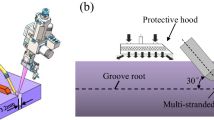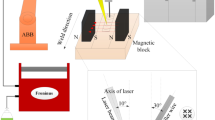Abstract
The increasingly stringent performance requirements for spark ignition engines have necessitated the use of precious metals as spark plug electrodes. However, the welding quality of these electrodes must be improved. An Ir–Rh alloy and a Ni-based material were welded by focusing a fiber laser with different offsets close to the weld centerline. Optical microscopy, scanning electron microscopy (SEM), and energy-dispersive spectroscopy (EDS) were conducted to analyze the microstructure and bonding mechanism of the welding seam as well as thermal fatigue performance. The welding seam mainly consists of an Ir–Ni solid solution, with a thin intermetallic compound (IMC) layer formed at the Ni-welded metal interface. Thermal fatigue experiment (TFE) results indicated that the thermal fatigue resistance is affected by thermal stress and high-temperature oxidation, and the dominant factor changes with the change in the laser beam offset. The joint exhibited the highest breakdown force of 163.3 N when the laser offset was 0.1 mm on the Ni side. Further, fracture only occurred on the Ir–Rh fusion line area, with different fracture mechanisms being observed. The results showed that the welding quality and thermal fatigue resistance of Ir–Rh/ Ni-based alloy joint were significantly improved by using an appropriate laser offset setting, which also reduced the abnormal expiration probability of the spark plug.

















Similar content being viewed by others
Data availability
All data generated or analyzed during this study are included in this published article.
Code availability
Not applicable.
References
Wei H, Zhu T, Shu G, Tan L, Wang Y (2012) Gasoline engine exhaust gas recirculation—a review. Appl Energy 99:534–544. https://doi.org/10.1016/j.apenergy.2012.05.011
Pastor JV, Garcia-Oliver JM, Garcia A, Mico C, Durrett R (2013) A spectroscopy study of gasoline partially premixed compression ignition spark assisted combustion. Appl Energy 104:568–575. https://doi.org/10.1016/j.apenergy.2012.11.030
Du Y, Yu X, Wang J, Wu H, Dong W, Gu J (2016) Research on combustion and emission characteristics of a lean burn gasoline engine with hydrogen direct-injection. Int J Hydrog Energy 41:3240–3248. https://doi.org/10.1016/j.ijhydene.2015.12.025
Linkenheil K, Ruoss HO, Grau T, Seidel J, Heinrich W (2005) Novel spark-plug for improved ignition in engines with gasoline direct injection (GDI). IEEE Trans Plasma Sci 33:1696–1702. https://doi.org/10.1109/TPS.2005.856409
Gong C, Sun J, Liu F (2020) Numerical study of twin-spark plug arrangement effects on flame, combustion and emissions of a medium compression ratio direct-injection methanol engine. Fuel 279:118427. https://doi.org/10.1016/j.fuel.2020.118427
Murakami R, Kamada K, Shoji Y, Yokota Y, Yoshino M, Kurosawa S, Ohashi Y, Yamaji A, Yoshikawa A (2018) Fabrication of flexible Ir and Ir-Rh wires and application for thermocouple. J Cryst Growth 487:72–77. https://doi.org/10.1016/j.jcrysgro.2018.01.018
Bao ZB, Murakami H, Yamabe-Mitarai Y (2014) Microstructure and oxidation behaviour of Ir-rich Ir-Al binary alloys. Corros Sci 87:306–311. https://doi.org/10.1016/j.corsci.2014.06.038
Panfilov P, Yermakov A, Antonova O, Pilyugin V (2009) Plastic deformation of polycrystalline iridium at room temperature. Platin Met Rev 53:138–146. https://doi.org/10.1595/147106709X463318
Grabas B, Tofil S, Napadłek W (2016) An analysis of laser-welded Nicr-Ir and Nicr-Pt micro joints on spark plug electrodes in biogas-fuelled engines. Arch Metall Mater 61:1163–1167. https://doi.org/10.1515/amm-2016-0194
Zhao S, Xia J, Xia Y, Chen J, Du D, Yang H, Liu J (2019) Microstructure and isothermal oxidation of Ir–Rh spark plug electrodes. Materials 12:3226. https://doi.org/10.3390/ma12193226
Katayama S, Kawahito Y, Mizutani M (2010) Elucidation of laser welding phenomena and factors affecting weld penetration and welding defects. Phys Procedia 5:9–17. https://doi.org/10.1016/j.phpro.2010.08.024
Chu Q, Bai R, Jian H, Lei Z, Cheng Y (2018) Microstructure, texture and mechanical properties of 6061 aluminum laser beam welded joints. Mater Charact 137:269–276. https://doi.org/10.1016/j.matchar.2018.01.030
Zhang Y, Lu F, Wang HP, Wang X, Cui H, Tang X (2015) Reduced hot cracking susceptibility by controlling the fusion ratio in dissimilar laser welding Al alloys joints. J Mater Res 30:993–1001. https://doi.org/10.1557/jmr.2015.64
Zhou L, Luo LY, Tan CW, Li ZY, Song XG, Zhao HY, Huang YX, Feng JC (2018) Effect of welding speed on microstructural evolution and mechanical properties of laser welded-brazed Al/brass dissimilar joints. Opt Laser Technol 98:234–246. https://doi.org/10.1016/j.optlastec.2017.08.004
Casalino G, Mortello M, Peyre P (2015) Yb–YAG laser offset welding of AA5754 and T40 butt joint. J Mater Process Technol 223:139–149. https://doi.org/10.1016/j.jmatprotec.2015.04.003
Zhao Y, Wang W, Yan K, Liu C, Zou J (2018) Microstructure and properties of Cu/Ti laser welded joints. J Mater Process Technol 257:244–249. https://doi.org/10.1016/j.jmatprotec.2018.03.001
Zhou L, Li ZY, Song XG, Tan CW, He ZZ (2017) Influence of laser offset on laser welding-brazing of Al/brass dissimilar alloys. J Alloys Compd. https://doi.org/10.1016/j.jallcom.2017.05.099
Miao Y, Han D, Yao J, Li F (2010) Effect of laser offsets on joint performance of laser penetration brazing for magnesium alloy and steel. Mater Des 31:3121–3126. https://doi.org/10.1016/j.matdes.2009.12.035
Yokokawa T, Osawa M, Nishida K, Kobayashi T, Koizumi Y, Harada H (2003) Partitioning behavior of platinum group metals on the γ and γ′ phases of Ni-base superalloys at high temperatures. Scripta Mater 49:1041–1046. https://doi.org/10.1016/S1359-6462(03)00437-8
Pugh S (1991) An introduction to grain boundary fracture in metals. CRC Press, Florida
Funding
This research was supported by the Hunan Science and Technology Program of Strategic Emerging Industries (2016GK4031) and the Hunan Innovation Platform and Talent Program (2016TP2022).
Author information
Authors and Affiliations
Corresponding author
Ethics declarations
Ethics approval
Not applicable.
Consent to participate
Not applicable.
Consent for publication
Not applicable.
Competing interests
The author declares no competing interests.
Additional information
Publisher's Note
Springer Nature remains neutral with regard to jurisdictional claims in published maps and institutional affiliations.
Rights and permissions
About this article
Cite this article
Zhao, S. Effect of laser offset on microstructure and mechanical properties of Ir–Rh/Ni-based alloy. Int J Adv Manuf Technol 119, 4893–4906 (2022). https://doi.org/10.1007/s00170-021-08271-0
Received:
Accepted:
Published:
Issue Date:
DOI: https://doi.org/10.1007/s00170-021-08271-0




